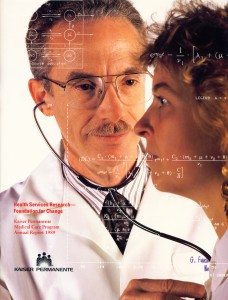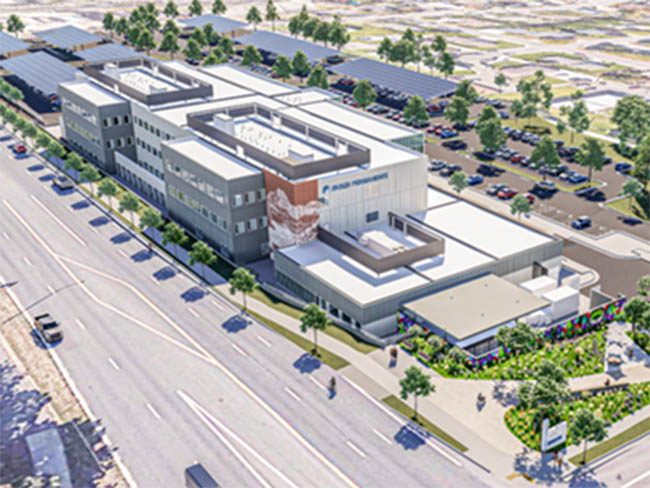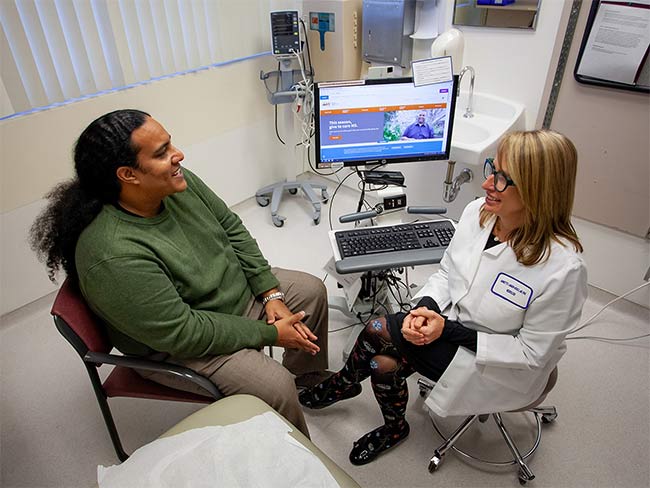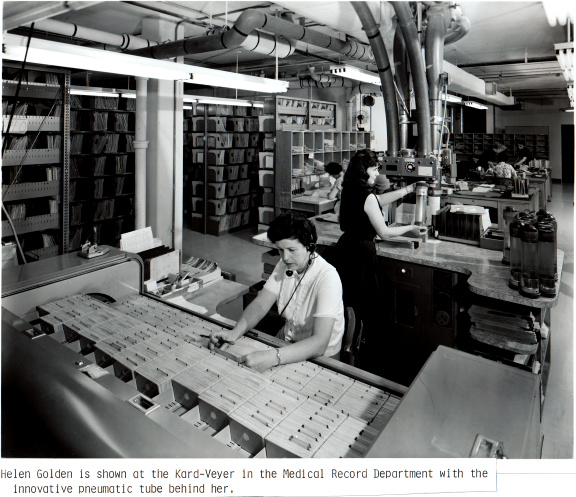Decades of health records fuel Kaiser Permanente research
Over 50 years of early Kaiser Permanente electronic health records since the sixties served as the basis for Kaiser Permanente's longitudinal research projects.
Inside a Kaiser Permanente paper chart room before electronic health records. Kaiser Permanente Heritage photo

Former Northern California Division of Research Director Gary Friedman, MD, with patient, on the cover of the 1989 Kaiser Permanente Annual Report.
In a highly technological world, paper medical charts no longer show up in Kaiser Permanente doctors’ hands when they interact with today’s tech-savvy patients. These collections of hand-written notes of our medical complaints, drug prescriptions, lab tests, and more, are going the way of fax machines and typewriters.
They’ve been replaced by Kaiser Permanente’s award-winning electronic medical record system, Kaiser Permanente HealthConnect®, which brings patients much closer to their providers.1
But preserved paper patient records going back to World War II will continue to be a valuable asset for research, even as we trade in the old cumbersome model for the new.
Gary Friedman, MD, retired director of the Kaiser Permanente Division of Research in Oakland, Calif., says Kaiser Permanente’s medical records — whether the original hard copies or digital files — are valuable assets to allow groundbreaking research.
In a 1998 article in The Permanente Journal, Friedman wrote: “Our collection of manual charts going back over 50 years is a national treasure and must be preserved despite the storage and retrieval costs entailed.”
In his 2006 oral history, Friedman said the highly touted study on the value of sigmoidoscopy in preventing colon cancer relied on paper records going back to the 1970s.2
He added: “(In) a recent study I did on the early symptoms of ovarian cancer (we found) by going into the charts (paper records) we could get much more of what the physicians recorded in text about the symptoms these women were having ... Who knows what question might come up in the future (that could be answered) by looking at these charts that go back to the mid-1940s?”
Kaiser Permanente’s early foray into digital world
Kaiser Permanente’s journey into electronic record keeping started around 1960 and took advantage of emerging computer technology. A desire to prevent chronic disease through pre-symptom screening supplied the motivation to automate routine tests and to compile anonymous patient data for population-based research.
Barbara Breen, a medical assistant at Kaiser Permanente Oakland Medical Center in the early 1970s, had her hands on paper charts as well as on the pioneering electronic medical records of the day. She often stood by as lunchtime relief to ensure the computer ran fluidly as it processed punch cards that coded the results of patient visits for Kaiser Permanente’s complete physical (multiphasic) examination.
She was on the cutting edge of computer technology at the time and was in awe. “I got to see all these brand new machines and they assigned me to the spirometer (to test lung capacity),” Breen recalled recently. “The patients filled out a medical questionnaire (health assessment) and had 90 minutes to go around to all the cubicles where they had the tests.”
Data collected by Breen and others in the multiphasic unit were fed into early computers that took up the basement at 3779 Piedmont Ave., just off of MacArthur Boulevard near Kaiser Permanente’s flagship medical center in Oakland, Calif.
Tracking members’ health over decades
Over the years, these records, now considered invaluable and precious, have been the basis for many Kaiser Permanente longitudinal research projects. Collection of detailed patient data from 1964 to 1972 was made possible by the pioneering computer work of Morris Collen, MD, largely funded by the federal government.

Barbara Breen, on the Kaiser Permanente staff for 30 years, had her hands on paper charts as well as early electronic health records.
Breen, who worked for Kaiser Permanente for 30 years, mostly in the northern San Francisco Bay Area, recalls having the duty to retrieve charts for patients scheduled to come into the San Rafael facilities in the 1970s.
“I got a job down on Fourth Street, which was an old motel. General Medicine was downstairs, and Internal Medicine was upstairs, and the garage next door is where all the charts were. And in those days, we didn’t have (access to) computers yet, so if you needed a chart ASAP, you would order it by phone.
“The chart room didn’t always have an extra person to bring the chart over. So the medical assistant or other (staff person) went out, rain or shine, across the parking lot, into the remodeled garage, and picked up your chart.”
Today, Kaiser Permanente medical centers are constructed without medical chart rooms, indicating a confidence that the electronic chart is here to stay. With KP HealthConnect in place, patients get their routine test results much quicker, and they can discuss their care with their physicians via secure email and mobile devices.
For member convenience, patients who travel can have their medical data downloaded onto a memory stick to take wherever they go. For quality of care, physicians have access to patients’ medical information in any of Kaiser Permanente’s facilities nationwide, enabling better care and avoiding duplication of tests.
1 Kaiser Permanente has been awarded Stage 7 honors by the Health Information Management Systems Society Analytics for 36 of its hospitals. Stage 7 is the highest award in the category and recognizes environments in which paper charts are no longer used to deliver patient care. KP was also honored with the HIMSS Davis Award for Excellence for 2011. The 2013 annual HIMSS conference is underway in New Orleans through Thursday, March 7.
2 Selby, JV, Friedman, GD, Quesenberry CP Jr, Weiss NS. A case-control study of screening sigmoidoscopy and mortality from colorectal cancer. New England Journal of Medicine 1992.




























































































